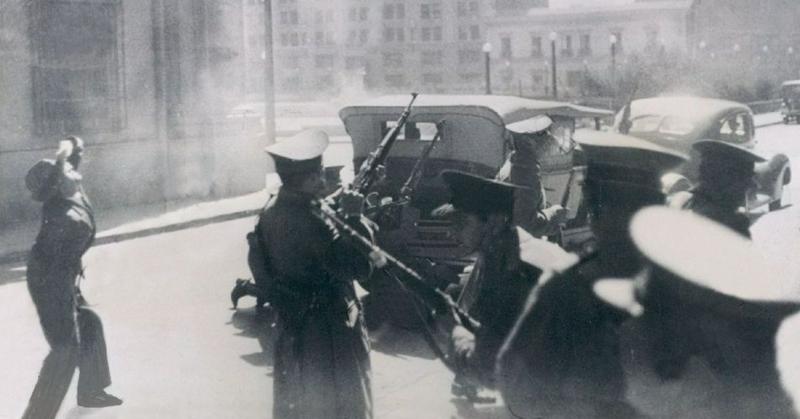A Modern History Of Failed Coups: How Political Uprisings Go In Today's Societies
By | November 1, 2020

People have been plotting to take over the government for approximately as long as government has existed, but for every successful coup, there are hundreds that failed spectacularly. Some failed coups end in a deluge of violence that do nothing but divide their countrymen even more, while others just kind of peter out when it becomes clear that they won't work.
The Seguro Obrero Massacre
In 1938, Chile was embroiled in a heated presidential election that pitted liberal-conservative Gustavo Ross Santa María against the Popular Front's Pedro Aguirre Cerda and the newly formed Popular Alliance candidate, who also happened to be backed by the National Socialist movement of Chile, Carlos Ibáñez del Campo. On September 5, when it looked as if Ross was going to take the win, a group of about 30 Chilean Nazis took over the Seguro Obrero building to install Ibáñez by force.
In short order, a team of carabineros (the Chilean national police) started firing on the invaders as an entirely different group of young Nazis occupied a building at the nearby University of Chile. A shootout followed, ending with the surrender of the University camp, who were marched to the Seguro Obrero building to talk some sense into their comrades. They lured its occupants out on the promise that the carabineros would be totes chill about the whole thing and immediately made liars of themselves when said carabineros lined all 60-ish surrendered Nazis against a wall and shot them. There were only four survivors.

The 1973 Chilean Coup D'état
In the early '70s, the United States was worried about Chile's president, Salvador Allende, pushing the country into socialism, so the C.I.A. (and President Nixon) quietly funneled some money to his opposing parties. They also provided funds to groups who were known to be plotting coups.
On September 11, 1973, the Chilean navy took over the port city of Valparaiso as tanks pushed in on President Allende's palace in downtown Santiago, and all hell broke loose when Augusto Pinochet ordered soldiers to attack the building and fighter jets to fire on the palace. As Allende's supporters ran from the carnage, they were gathered up, tortured, and killed. Officially, Allende died of suicide in his palace, although some believe that his suicide was staged after the fact. Pinochet led the country for the next 17 years.

The 1953 Iranian Coup D'état
Led by senior C.I.A. agent Kermit Roosevelt, two coups were carried out in the span of four days in August 1953 in an attempt to destabilize Iran's government, remove the beloved Prime Minister Mohammad Mossadegh (who nationalized the Iranian oil industry, which the U.S. didn't care for), and replace him with Mohammad Reza Pahlavi, the last Shah of Iran.
This was the intelligence agency's first big coup, and they swung hard on it. Roosevelt bought off the Iranian press and began circulating anti-Mossadegh propaganda before convincing the Islamic clergy that Mossadegh posed a threat, at which point the C.I.A. attempted to abduct Mossadegh at his home. After he fought them off, they bailed on the initial coup and regrouped.
Following the failed coup, the C.I.A. planned a second one that not only unseated Mossadegh but put him in prison for three years. After his release, he was put on house arrest for the rest of his life. Thanks to the coup, Iran split its oil revenues 50–50 with an international consortium that controlled production and marketing.

The August Coup
After becoming the president of the U.S.S.R. in 1988, Mikhail Gorbachev tried to bring the Soviet Union closer to the West with diplomacy and an entrance into the free market. Conservative communists thought he was bringing the country down, so a motley crew of politicians, military, and the K.G.B. came together to unseat Gorbachev.
On August 18, 1991, hardcore communists attempted to seize power from the president by locking him inside his vacation villa before demanding that he resign his post. Unfortunately for them, the guys behind the coup weren't on the same page. Their leaders argued among themselves while reportedly drinking copiously.
The coup fell apart on August 21, after the newly elected president of Russia, Boris Yeltsin, denounced it and organized street protests with the Russian people. In December, Gorbachev resigned as the leader of the Soviet Union, so the whole coup thing turned out to be not only unsuccessful but unnecessary.

The 1986–90 Philippine Coup Attempts
Between 1986 and 1990, loyalists of former Philippine President Ferdinand Marcos attempted multiple coups to unseat his successor, Corazon Aquino. One in November 1986 and another in July 1987 were stopped before they could even start, but one coup in August 1987 left 53 people dead after soldiers attacked the presidential palace. Two years later, rebels bombed the palace and took over the Air Force headquarters and two broadcast stations before they were quelled.

The Business Plot
In 1933, the top tier of American businessmen allegedly attempted to overthrow President Franklin Delano Roosevelt. According to retired Marine Corps Major General Smedley Butler, conservative members of the business sector bristled at Roosevelt's campaign promises to create scores of new government jobs and end the gold standard, so they planned to form a fascist veterans' organization led by Butler to evict the Squire of Hyde Park. It's not clear if anyone actually tried to topple Roosevelt's presidency, but while this alleged coup has been presented as fanciful, it's not unfeasible that a small group of financiers might try to take over the White House with someone with a big love for capitalism.

